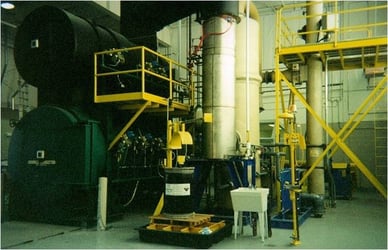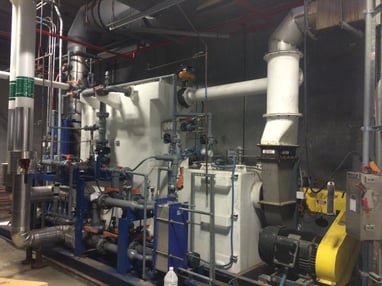Acid gas scrubbers are one of the most common types of air pollution control systems found in industry. They are often used to treat exhaust gases from combustion sources such as incinerators, hazardous waste combustors, thermal oxidizers, regenerative thermal oxidizers (RTO), furnaces, and direct fired heaters. Acid gas scrubbers are found on a wide range of facilities including, geothermal plants, secondary lead smelters, waste oil re-refiners, refineries, chemical and pharmaceutical plants, and mineral and metal processing facilities. The most common types of acid gas emissions are HCl and SO2, but can also include Cl2, HBr, HF, and NOx.
Most acid gas scrubbers are wet scrubbers using vertical packed bed absorbers. In the case of combustion sources, the scrubber is coupled to an evaporative quencher to cool the gas to saturation before it passes to the packed bed. This arrangement is shown in the adjacent figure for a medical waste  incinerator. The incinerator exhaust is ducted to a metal quencher (shown in the foreground). The hot gas enters the top of the quencher and flows vertically downward. The gas then elbows into the bottom of a vertical packed bed scrubber (shown in the background). The gas passes upward through the packed bed as re-circulated water flows downward, counter-current to the gas from the top of the packed bed. Water from the quencher and packed bed is collected in the sump and re-circulated back to the quencher and packed bed. An entrainment separator at the top of the scrubber removes entrained water droplets. After exiting the scrubber vessel, an interconnect duct transports the gas to a induced draft fan located at grade.
incinerator. The incinerator exhaust is ducted to a metal quencher (shown in the foreground). The hot gas enters the top of the quencher and flows vertically downward. The gas then elbows into the bottom of a vertical packed bed scrubber (shown in the background). The gas passes upward through the packed bed as re-circulated water flows downward, counter-current to the gas from the top of the packed bed. Water from the quencher and packed bed is collected in the sump and re-circulated back to the quencher and packed bed. An entrainment separator at the top of the scrubber removes entrained water droplets. After exiting the scrubber vessel, an interconnect duct transports the gas to a induced draft fan located at grade.
The scrubber above is one of the earliest Envitech medical waste incinerator scrubbers. These types of scrubbers are often installed in hospitals where critical design considerations include limited space, low ceilings, and difficult to reach locations through elevators and narrow corridors. To help minimize installation costs Envitech developed a rectangular scrubber which is shown in the figure below.

This configuration provides several advantages over a vertical scrubber, including:
Greater integration and pre-assembly of ancillary equipment and pumps, piping, valves, and fittings.
- Ground level access manways for safer, easier maintenance.
- Simplified ductwork connection to the fan and stack.
- Elimination of caged ladders and platforms for nozzle and mist eliminator access.
- Ability to fit in locations with low head space.
- Simplified requirements for setting and integrating equipment which lowers installation costs.
The rectangular scrubber has been used on over 60 installations. Envitech has found that facilities tend to prefer a rectangular design over a vertical scrubber for the advantages noted above. In some cases, total installed cost is reduced by 40% to 50%. Weather a scrubber is purchased from an EPC contractor, upstream equipment supplier, or architectural & engineering firm, it is recommended that facility preferences be taken into consideration in the final selection process.
The video link below shows a few recently installed rectangular scrubbers at waste oil re-refiners as well as several examples of other rectangular scrubber installations.
Click the link below for a free case study on a rectangular acid gas scrubber for a direct fired heater at a waste oil re-refiner.
Click the link below for a free case study on a rectangular medical waste incinerator scrubber for the control of acid gases, particulate, and heavy metals.



